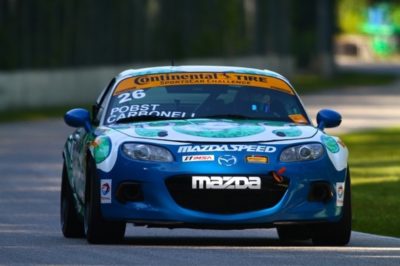Switching from car to car doesn’t have to be dramatic, says club and pro racer Andrew Carbonell.
Andrew Carbonell has driven a variety of MX-5s. In addition, he has some karting and formula car experience plus some time in the GX-class Mazda SKYACTIV-D Clean Diesels that ran in the Rolex Sports Car Series last year. This year, he’s racing both a Freedom Autosport MX-5 in IMSA Continental Tire SportsCar Challenge [CTSCC] Street Tuner class with teammate Randy Pobst and a Spec Miata in SCCA Club Racing. So going from car to car is nothing new. So, Andrew…any advice for someone trying to adjust to a new ride?
“Once you’re driving a car to its limit, it doesn’t really matter what you’re driving,” he says. “Once you’re into that threshold braking zone and that maximum lateral-g cornering capability, once you’re in the zone of maximum tire grip, that whole idea [of different cars] kind of goes away. Now it’s down to the basics. It’s carrying your entry speed, feeling the maximum grip of each tire and kind of waiting for when it’s time to get back on the throttle or get off the throttle.”
In short, although the limits may be different, exploiting those limits doesn’t really change.
“The only difference you feel between cars mostly is going down the straightaway, how fast you’re going or the way it sounds. But you get over that pretty quickly and really what’s important is once you get on the brakes, how it turns and how it handles,” he explains.
Spec Miata, Mazda MX-5 Cup and the CTSCC car get progressively less soft. Technology also creeps in as you move up the MX-5 racing ladder.
“The ABS in the MX-5 Cup cars is a little intrusive compared to Spec Miatas where you have no ABS. You have the ABS coupled with power steering in the Cup car. It feels a little delayed in comparison,” Carbonell says.
Both the Spec Miata and MX-5 Cup cars are not far removed from production. Stiffer, certainly, and lighter thanks to the removal of all the superfluous stuff not needed for racing, and even a little louder thanks to alternate exhausts. But the CTSCC car is a bigger step
“It’s faster, it’s louder, it’s stiffer. It has a different differential, way different shock and spring package, different motor. So it reacts quite differently. Not that it’s on the ragged edge…but it is. It can be a handful sometimes, where the other cars are more forgiving. It’s being stretched so thin to compete with the other cars, so you’ve got to drive it on a fine edge. Randy [Pobst] and I are always trying to calm that little thing down. It’s a race car. You really feel like you’re squeezing every last drop out of that car.”
